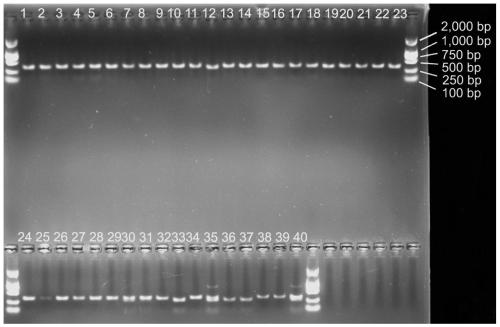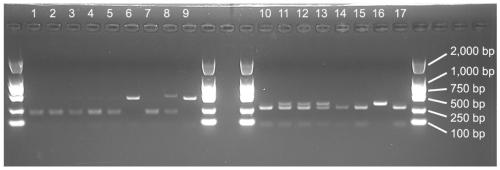SNP locus based CAPs molecular marker for identifying single seeds of amaranthus palmeri, amaranthus tuberculatus and amaranthus aeronicola and applications of molecular marker
A molecular marker, Amaranthus amaranthus technology, applied in the field of molecular biology, can solve the problems of hindering application, long detection time, high cost and high cost, and achieve the effect of accurate and effective identification method, accurate detection and identification, and reliable detection method.
- Summary
- Abstract
- Description
- Claims
- Application Information
AI Technical Summary
Problems solved by technology
Method used
Image
Examples
Embodiment 1
[0040] Example 1 SNP sites and acquisition of CAPs molecular markers based on SNP sites
[0041] By analyzing and comparing the sequences of 18S, ITS, 26S and other genes of 52 samples from 18 species of Amaranthus L., and analyzing their phylogenetic relationships and sequence differences, the results were used to distinguish between amaranth and amaranth The SNP sites of Amaranthus sylvestris and other plants of the genus Amaranth, wherein the SNP site used to distinguish Amaranthus sylvestris from other plants of the genus Amaranth is located at position 233 of the sequence shown in SEQ ID NO.1. This position is A, and that of other amaranth plants is C. The SNP site used to distinguish Amaranthus squarrosa / Amaranthus from other amaranths is located at the 200th position of the sequence shown in SEQ ID NO.2. The position of Amaranthus squarrosa and Amaranthus sphaerocarpa is C, and other amaranths This site in plants is A / T.
[0042] The specific names and sources of the 52 pl...
Embodiment 2
[0060] Example 2 Method for distinguishing and identifying single seeds of Amaranthus longifolia, Amaranthus scabra, Amaranthus dulcis and other amaranth plants
[0061] The CAPs molecular markers provided in Example 1 and their specific detection primers were used to identify Amaranthus longifolia, Amaranthus scabra, and Amaranthus sphaerocephala. The specific methods are as follows:
[0062] 1. DNA extraction
[0063] Grind the single seed of the amaranth plant to be tested and place it in a 1.5ml centrifuge tube, use Lysase A in a water bath at 95°C for 10 minutes, and centrifuge for 2 minutes for later use.
[0064] 2. PCR amplification
[0065] (1) Amplification of CAPs molecular marker shown in SEQ ID NO.1
[0066] Using the DNA obtained in step 1 as a template, the forward primer 78F: 5'-GTCCCTGCCCTTTGTACACA-3' and the reverse primer 419R: 5'-GGGTTCGTTGTTGCATCGAG-3' were used for PCR amplification.
[0067] The PCR reaction system in 50μl is: 30ng / μl template DNA 1μl, 10pmol / μl pri...
Embodiment 3
[0080] Example 3 Discrimination and identification of Amaranthus longifolia, Amaranthus scabra and Amaranthus sylvestris
[0081] The single seeds of 52 plant material samples shown in Table 1 were used as the samples to be tested, and the method provided in Example 2 for distinguishing and identifying Amaranthus serrata, Amaranthus scabra, Amaranthus sylvestris, and other amaranths was used to perform Amaranthus spp. Discrimination and identification of seeds of Amaranthus scaber and Amaranthus sphaerocephala.
[0082] A mixed sample of single seeds of different plant materials in 52 plant material samples shown in Table 1 was used as a control.
PUM
 Login to View More
Login to View More Abstract
Description
Claims
Application Information
 Login to View More
Login to View More - R&D
- Intellectual Property
- Life Sciences
- Materials
- Tech Scout
- Unparalleled Data Quality
- Higher Quality Content
- 60% Fewer Hallucinations
Browse by: Latest US Patents, China's latest patents, Technical Efficacy Thesaurus, Application Domain, Technology Topic, Popular Technical Reports.
© 2025 PatSnap. All rights reserved.Legal|Privacy policy|Modern Slavery Act Transparency Statement|Sitemap|About US| Contact US: help@patsnap.com



